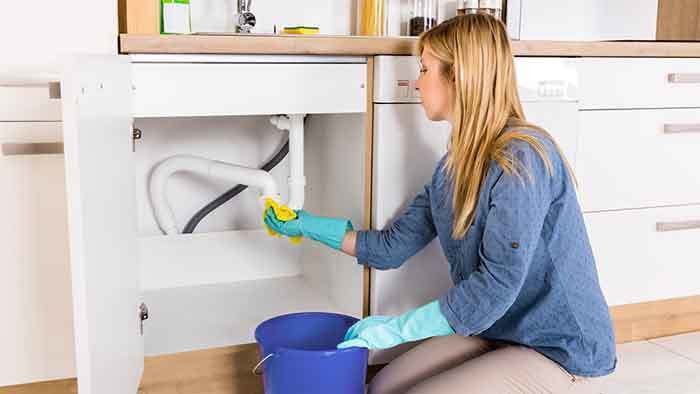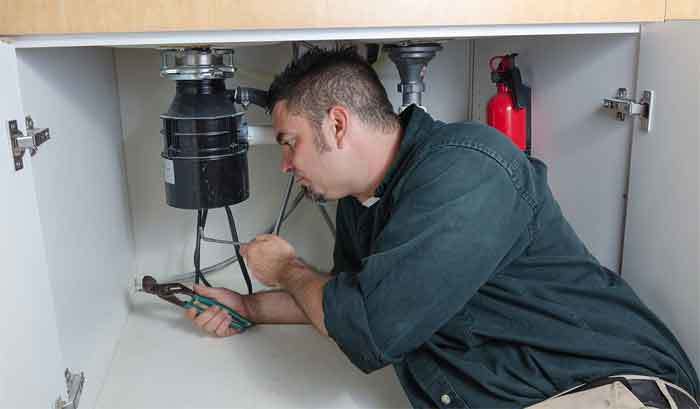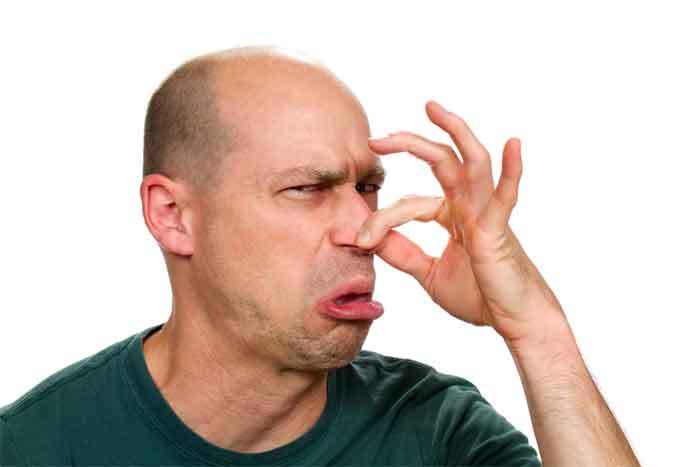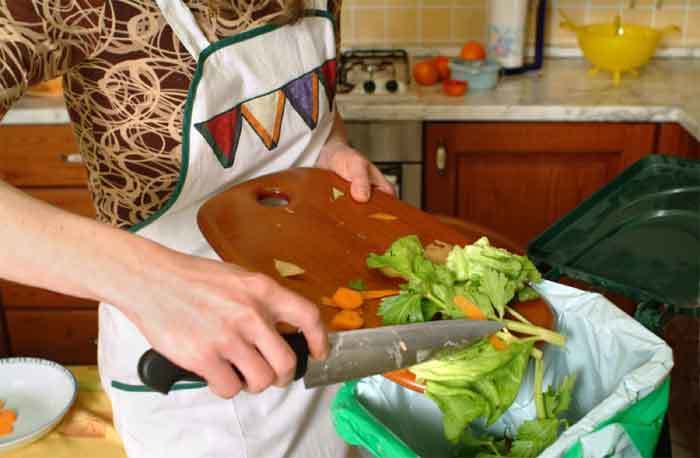Disclaimer: This post may contain affiliate links, meaning we get a small commission if you make a purchase through our links, at no cost to you. For more information, please visit our Disclaimer Page.
Notice an uncomfortable smell in the kitchen?
You checked the fridge but it's not coming from there? It's not coming from the trashcan either?
The source of the stench is probably coming from the garbage disposal because of leftover food from before who knows when.
Another sign that your garbage disposal is stuck is when you see water overflowing and not going away, even though it should.
Theoretically speaking, these machines are supposed to be self-cleaning, but over time food particles can catch on to parts they're not supposed to.
This always happens at homes that have a garbage disposal so calm down and let's take it step by step, by looking at numerous ways for cleaning a garbage disposal trap.

How to Clean Garbage Disposal Trap
Clean it manually
- Turn off the power. Please do this first so you don't cause any unnecessary damage to your tools or worse, your hands. Safety should always be your first concern. The switch is usually found under the cabinet or on the closest wall. If you don't find it, we suggest you remove the fuse that powers the machine from the main power panel. Never ever put your hand in the garbage disposal, even if it's turned off. It's simply not worth the risk.
- Have a look and check if you can see something big that is creating the clog. You can use a flashlight to help you see better. Try to find if the blockage is in a single solid form, is it greasy or is it maybe an object. If it's the latter it's best to use a pair of pliers and reach into the disposal. Grab it and remove it.
- Wait for the motor to cool off, 15 minutes should do and it's good to go. Turn the power on, press the reset button that is at the bottom of the disposal and voila! See how it's working normally again?
If the answer is no, then the clog is a little trickier to get out. Turn the power off again and insert a wooden spoon or a broom handle in the drain opening (again, never put your hand down the drain).
Insert it so that you can feel it bump into the impeller, which is the plate that holds the blades that grind up garbage. Move the handle left and right until you free the plate so that it moves normally again.
Now, wait for about 15 minutes again for the motor to cool off. Turn on the power and press the reset button.
Two-Sinks instructions to follow
In homes with two sinks, one used for dishes and other for disposing of garbage, the benefit is that you have everything close by.
On the other hand, problems that occur in one sink usually become a problem for both sinks. Sometimes it's hard to pinpoint why water is overflowing or not flushing because there are so many pipes. However, there are some guidelines:
- Make sure that the other sink has about 3 to 4 inches of water. If it has more than that use a bucket to bring some out, otherwise fill it so that it has the mentioned amount.
- Grab a sink plunger (not a toilet plunger, this one has a flat bottom) and center it over the drain opposite of the garbage disposal drain (which you should plug).
- Pump up and down fast repeatedly and feel the suction. If you don't hear it you should re-center the plunger in a way that it can create a vacuum effect. Once you're done put away the plunger and unplug the garbage disposal drain.
- Plug the drain you plunged and run water through the garbage disposal drain and if it doesn't flush then plunge the garbage disposal drain as well. Try running water again and if the problem persists plunge both drains again. If this doesn't work the clog is too far down the pipes and plunging won't do.

- Loosen the trap with a wrench or pliers. You'll notice the trap pipe because it resembles the letter U and it's located under the sink drain. Have an empty bucked beneath the sink prepared to collect water that might fall out of the pipes.
- Loosen the elbow pipe that connects the garbage disposal to the drain. Once removed check it to see if you can find any blockages or unwanted particles. Remove them and rinse the pipe.
- If the clog is not there either, you can check the tailpiece pipe which is the vertical pipe that runs down the sink drain.
- If the problem isn't solved yet, you're going to have to use a plumbing snake. Insert it into the main drain pipe that is in the wall. Turn it in a circular motion until you feel resistance and when you do - push. Push until you feel that the blockage is pushed through enough so you can pull out the blockage along with the snake.
- This is optional, but when you are putting the pipes back together you can replace old ones if they are rusty or damaged in some other way. Tighten the connections and run hot water through both drains to check if everything is working fine.
How to fix it the easier way?
First, place a stopper in the sink and fill it with boiling water before adding an inch of soap. Unplug the sink and let the water flush (you already do this all the time if you wash the dishes by hand).
After this, you can put ice cubes in the disposal so that it cleans the blockage and sharpens the blades in the garbage disposal. To make the ice more effective, you can smudge it in salt so that it helps with removing food.
After this part, to completely remove the stench you can pour lemon or orange juice down the drain so that it leaves a nice citrus smell behind it and deodorizes the unit.

If the problem persists, you can use baking soda and vinegar. Put the mix in the garbage disposal, let it sit there for about 10 minutes and flush everything down with boiling water.
This should definitely do the trick. If you don't have baking soda lying around your home you can just use vinegar, it works well on its own also.
If you don't want to be a handyman on your own and meddle with creating mixes, you can always opt out to use a chemical cleaner.
There are a number of options out there, just be careful with how much you pour in the drain and how often. These mixes could damage your pipes, although it's not common practice.
How to prevent this in the future?
Here is a piece of advice directly from plumbers - don't turn off the garbage disposal immediately after it sounds like all of the food is chopped up.
Instead, leave it running for at least 5 seconds after you think everything is broken into pieces. Better to be sure and let it crumble everything up nicely so that nothing gets stuck.
Although we've said that garbage disposals get stuck sooner or later, there are some things you can do to minimize the chance of it happening sooner.

Avoid dropping foreign objects in the drain, like forks, spoons or glass. Remember to run water always after using the machine because you don't want any food particles remaining. Never expect from your garbage disposal to crunch everything that you put in it.
Fats, oils and grease (you can remember them easily as FOG) are the main perpetrators of clogs and headaches. They usually come from pans and pots you use to fry and although it seems the sink is clean, inside is a different story - a greasy one.
These substances quickly solidify and catch on to other food or hair that goes down the drain. This can even fasten rusting of pipes, so really try to be careful with FOG.

Other things you should definitely avoid letting through the garbage disposal drain are egg shells, banana peels, nuts, pasta, rice, coffee grounds and other food that is hard to break or prone to stretching.
Final Thoughts: On Cleaning Garbage Disposal Trap
Remember that ground up doesn't mean gone completely. Just because you have a good garbage disposal doesn't mean that you can put everything in it. All it takes to form a clog is a bit of greasy residue and a moment of carelessness.
Not paying attention to what goes in the garbage drain will lead to a risk of its functionality. It's best to use paper towels to pick up hard food leftovers or to wipe grease from plates, pots and pans.
When in doubt, throw it in the trashcan, rather than letting the garbage disposal deal with it.
Prevention comes down to paying attention to what goes down the drain. That's all the is to it and that's the key to having an odorless kitchen with well-functioning drains.
